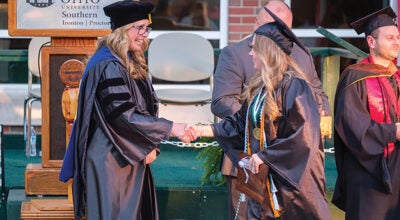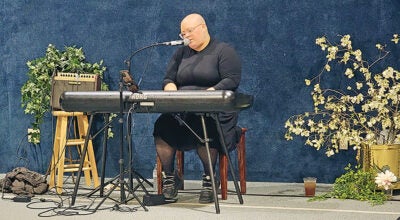Keeping the Faithful
Published 12:44 am Sunday, September 14, 2008
“For where two or three are gathered together in my name, there am I in the midst of them.”
— Matthew 18:20
Why stop at two or three? Make it two or three thousand. Better still, go for 20, or 30,000.
Thus spake the philosophy of the mega church, the pop lingo phrase for the religious phenomenon that has taken over the U.S. in less than two decades.
A report by Forbes.com calls the mega churches mega businesses, “where pastors often act as chief executives and use business tactics to grow their congregations.”
In 2003 Joel Osteen, the New York Times bestselling author and senior pastor of Lakewood Church in Houston, attracted Sunday attendance of more than 25,000. Close by was the World Changers ministry of Creflo Dollar, based in College Park, Ga., at 23,000, Forbes reported.
According to John Vaughn, founder of Church Growth Today, three decades ago there were about 10 mega churches in the U.S. That figure shot up to 250 in 1990, according to Forbes.
Now comes the quick question: Why?
“We have lost our status for sure,” the Rev. Jan. Williams, pastor of First Presbyterian Church in Ironton, says about the mainline churches. “I think relevance is the issue in people’s mind who write off the mainline churches because they have a concept of old and stodgy. The mega churches are young and have ministries to fit any possible need. They have staff and money.”
Williams sees three basic messages from the Old and New Testament teachings: freedom from bondage; freedom from exile; and atonement. These ancient messages can be made applicable to modern times when you look at bondage not as slavery of the Israelites but as slavery to today’s addictions be it alcohol, drugs or sex, Modern day exile becomes the sense of isolation that comes from today’s society. A church can provide the disenfranchised a new home.
Personally Williams likes O’Steen and a counterpart, television evangelist Joyce Meyer.
“O’Steen and Meyer are extremely popular,” Williams said. “He is very appealing, funny, always starts with a joke. The appeal is more energy. It’s the same message that mainline churches had all along and are not getting it out there.”
Her explanation of the current status of churches parallels one set forth by Paul Harvey in a story in USAToday. Harvey is a professor of American history at the University of Colorado, whose specialty is American religious history.
“The growth of mega churches in recent decades has come about because of a common historic cycle in U.S. religious faith: faith institutions reinventing themselves to meet the consumerlike demands of worshippers,” USAToday reported.
“We have a market economy of religion,” Harvey told the newspaper. “Mega churches just show the instant adaptability of religious institutions. They reflect how Americans have morphed their religious institutions into the way they want them to be. Religious institutions have to respond to that.”
So where are all these people coming from?
For many a mega church experience is their first time worshipping in any type of community atmosphere. But another source for their congregants comes from the mainline churches, which have become overshadowed by these nondenominational gargantuans.
Census figures show that the Builders generation — those born before 1946 — makes up about 10 percent of the population in the U.S. However, that group has the largest percentage — 60 percent — that is church affiliated. As the generations get younger, the numbers of those who go to church decline.
Only 40 percent of the Baby Boomers, who are 29 percent of the population of the United States, have a membership with a church. Gen X comes in at an 18 percent church affiliation and Gen-Y, those born after 1978, make up only 12 percent of the church population.
“Unless we begin to attract the children and grandchildren of the people already here, we are going to face a huge decline,” Williams said.
Another woman in an Ironton pulpit is the Rev. Sallie Schissler, who is one of the rectors at Christ Church, the Episcopal parish in Lawrence County.
“Even though I read a lot about the decline of the mainline churches, that hasn’t been my experience in southern Ohio. The (Episcopal) diocese of southern Ohio has remained fairly steady,” Schissler said.
She sees the growth in the nondenominational mega churches as a commentary on the leadership skills of those in charge of those institutions.
“Nondenominational churches are appealing. Often that has to do with leadership. It has to do with a very charismatic leader,” she said. “Nondenominationals start with an individual’s vision. And I think there are people who do not see the value of belonging to a larger structured denomination. One of the things they like about it is they do not have to support a diocese, a larger structure, an administration.
“But that hasn’t been my experience here. I know what you know which is what I read. I have been in Virginia, West Virginia and Ohio for my adult life. In my experience those issues didn’t influence rural or suburban congregations.”
Interestingly, many of the members of the Episcopal Church in the U.S. follow the pattern of those affiliated with the mega churches. They come over from church hopping.
“A lot of people have come as adults to investigate,” Schissler said. “Some of the liturgy is attractive to people who have not had an experience with a liturgical church. The approach to Scripture becomes more attractive to adults and the fact we value people’s experiences.”
But whether it comes from reaching out to the younger generations of the faithful today or attracting those wanting a new home, Williams sees great hope for the more traditional churches.
“But mainline churches are starting to revive, in terms not as noticeable as the mega churches,” she said. “But our ministry needs to be relevant and open and affirming.”





